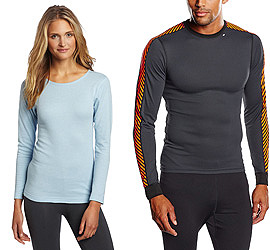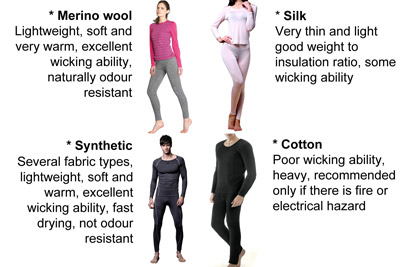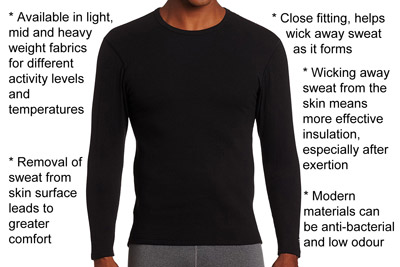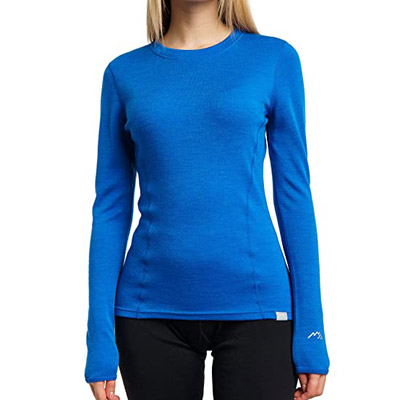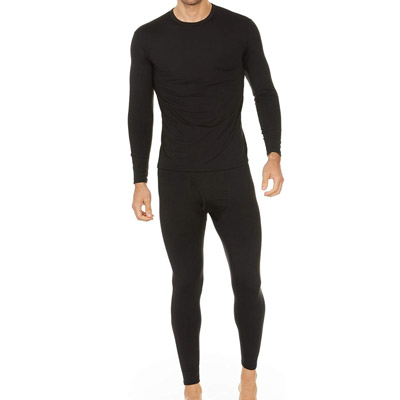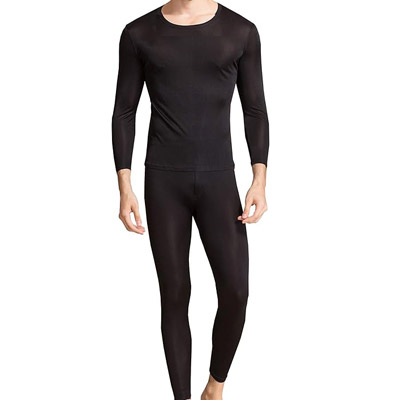Thermal Winter Underwear, Clothing for Cold Weather, The Base Layer
Thermal underwear next to the skin is the foundation or base layer for extreme cold weather clothing.
![]() This is the US page |
UK page
This is the US page |
UK page
![]() |
Australia / NZ page
|
Australia / NZ page
![]()
Weight / thickness
Lightweight - approx. 170 gm2
Midweight - approx. 250 gm2
Heavyweight - approx. 400 gm2
Which material?
The layer of clothing next to the skin has two jobs to do, the obvious one of keeping you warm and then the equally important but less obvious one of removing perspiration from the skin so it doesn't cause chilling later on.
The skin loses moisture at all times during exertion or not. It is more difficult for this perspiration to escape through insulating layers. If not allowed to do so it will result in discomfort with a feeling of clamminess as well as lowering the efficiency of the insulating layers.
Underwear able to wick this moisture away from the skin surface therefore becomes much more important. Modern "thermals" are made of natural merino wool or synthetic fibers that have good insulating properties and are also able to efficiently wick moisture away from the skin. The golden rule is avoid cotton except in some very specific situations.
Merino Wool - This has become the gold standard material for the foundation layer, it is not the budget option but it does deliver on performance. It is simply the wool of the merino sheep, a particularly soft and fine natural product. Merino wool garments deliver significant warmth with light weight, they are very good at wicking sweat away from the skin surface and so are particularly effective during exertion. They are naturally odor resistant and so can be worn for extended periods without changing or washing while keeping you as someone that others still want to be near.
Men's
merino base layers
Women's
merino base layers
Most popular merino wool base
layer brands
Meriwool
Minus33
Synthetic - A range of materials, polyester and polypropylene are commonly found as are proprietary versions (brand names) of generic fabrics. I could take a commercially available form of brushed polyester (say) and call it CoolAntarcticene for instance for a range of clothing. Synthetics wick sweat away from the skin very effectively, insulate well and are available in different weights, they dry faster than any of the other materials on this page, but are not so odor resistant, they may be treated to make them more so.
Men's
synthetic base layers
Women's
synthetic base layers
Most popular synthetic
base layer brands:
Lapasa
TSLA
Cotton - A traditional, natural material outperformed in most circumstances by the alternatives. Cotton doesn't wick sweat well which can make it feel cold and clammy after exertion, it is also relatively heavy and has a tendency to go a bit baggy with use, especially at knees and elbows. It is more fire and electrical resistant than most thermal underwear materials which makes it recommended and in some cases the only permitted material where these are a real hazard. Cotton may be better if you have skin allergies or you may simply prefer the feel of cotton.
Men's
cotton base layers
Women's
cotton base layers
Silk - Another natural material, thin and light weight delivering excellent insulation for minimal bulk. Not as effective as merino or synthetic, though silk really comes into its own in situations where looks matter, you can squeeze a silk layer under something else without it being noticed or where a matching or contrasting patch of colour enhances an outfit. It is also particularly delightful to the touch. A good choice for cold weather in the city under your office workwear.
Men's
silk base layers
Women's
silk base layers
Features of the base layer
Merino Wool
Base Layers
Synthetic Base Layers
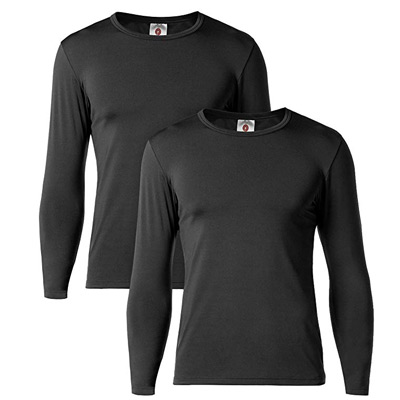
Men's - LAPASA Fleece Lined Long Sleeve Shirt | Women's, light mid or heavy weight, lots of colors
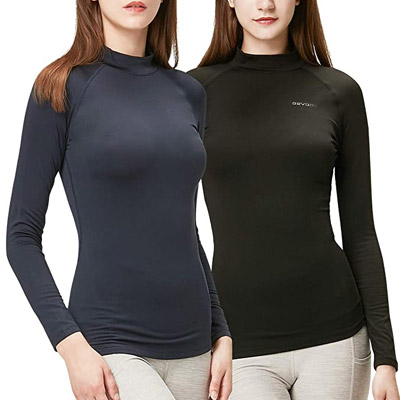
Women's - Devops compression baselayer thermal turtle neck - 2 pack | Men's, several colors
Cotton Base
Layers
Silk Base Layers

Women's - Terramar Thermasilk scoop neck top | bottoms | light and dark colors

